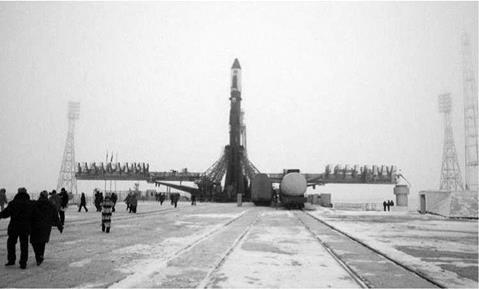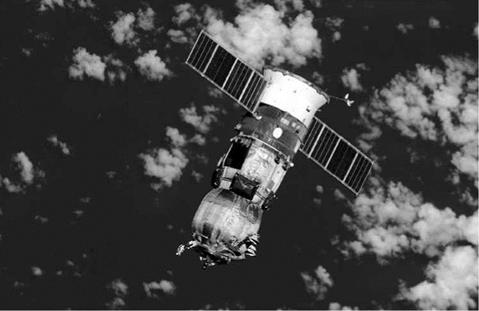Russia
Russia, or at least the Soviet Union, placed the first cosmonaut into space in April 1961, and has maintained a human spaceflight programme and cosmonaut group since that time. While NASA’s space programme is civil in nature, with considerable assistance from the US military, Russia’s space programme has been run by the military from the beginning.
Vostok was a one-man spacecraft, which introduced Russian cosmonauts to spaceflight. After six flights the propaganda requirements of Nikita Khrushchev dictated that Vostok was stripped out in order to allow it to carry three cosmonauts, and then to take two cosmonauts and an extendable airlock to allow for the first EVA before the Americans flew the first two-man crew and attempted an EVA in Project Gemini. The refitted Vostok spacecraft was called Voskhod to give the impression that it was an entirely new design. Vostok/Voskhod was replaced by Soyuz, a spacecraft designed to support an Earth orbital programme, or a human lunar landing programme, launched by the N-1. All of these programmes were developed by OBK-1, Sergei Pavlovich Korolev’s design bureau.
The earliest years of the Soviet human space programme were highlighted by a series of politically driven propaganda events, the first man in space, the first woman, the first three-man crew, the first EVA, and then it all went wrong. When the Soviet Premier changed in October 1964 and Korolev, the man in charge of the Soviet space programme, died on the operating table in January 1966, everything changed. The new premier, Leonid Brezhnev, had less interest in the space programme and Korolev’s replacement Vasili Mishin was not up to the job, faced as he was with racing America to the Moon, having started several years behind the Americans.
Meanwhile, a second design bureau, led by Valentin Chelomei, had designed the Proton launch vehicle and OKB-1 had designed the Soyuz-derived Zond to be launched on a Proton and carry a single cosmonaut on a high orbit that would pass around the far side of the Moon and fall straight back to Earth. When Apollo won the Moon race Russia cancelled both of its human circumlunar and lunar landing programmes.
Chelomei had begun a space station project in the mid-1960s, consisting of a crew/cargo ferry designated TKS and a station element designated OPS Almaz (despite this distinction, large Russian space station size modules based on the OPS Almaz element of this vehicle have generally come to be identified as “TKS modules’’ and this is the way in which the designation is used in this book). In December 1969, a decision had been made to have OKB-1 modify the OPS Almaz to operate with the Soyuz, and to serve as a scientific station rather than as a military reconnaissance platform. The scientific version of the Almaz station was originally called Zarya. Ultimately, both Almaz (military) and Zarya (scientific) versions of the station later flew under the cover name Salyut.
The first seven Salyut stations (two malfunctioned before they were occupied) supported a single Soyuz spacecraft, with their crews performing a series of recordbreaking long-duration flights, but the stations were left unoccupied between crew visits, just as the American Skylab prototype space station would be. Salyut-6 introduced two docking ports, one at each end of the station’s long axis. This allowed two Soyuz spacecraft to dock at the same time, leading to permanent occupancy and crew relief on-orbit. When crew occupations surpassed the 6-month guaranteed life of a Soyuz spacecraft the Soviets introduced 10-day Soyuz taxi flights, where two-man crews delivered a new spacecraft to the station and returned to Earth in the old one. Salyut-6 also saw the introduction of the Progress delivery vehicle carrying dry cargo in a pressurised compartment as well as liquid water and rocket propellant. Once the new cargo had been transferred to the station the pressurised compartment in the Progress was filled with rubbish and the spacecraft was undocked and commanded to re-enter the Earth’s atmosphere, where it was heated to destruction. Salyut-7 also received several TKS modules, each of which completed an automated rendezvous and docking, a precursor to the construction methods used to build the next generation of Soviet space stations. Indeed, in Salyut-6 and Salyut-7 the Soviets had rehearsed everything required for their third generation of space stations.
The Mir base block, launched in 1986, was the beginning of a new space station. The docking system at the module’s wake received Soyuz spacecraft, but also included the plumbing to support the liquid cargo deliveries from Progress spacecraft. At the module’s ram, the spherical node contained five docking systems. The one at the module’s ram was used for Soyuz spacecraft. When there were no Soyuz spacecraft docked, the system was also used to dock automated TKS-style modules, which were then moved to the radial ports and were accessed by the crew internally, from the node. When Communism collapsed in the Soviet Union, only two of the four Mir science modules had been launched. The remaining modules were only launched after they were fitted out using American money.
After the Russians had signed up to ISS, Mir became the location for a cooperative programme with the Americans, allowing their astronauts to gain long – duration flight experience. Prior to this, Mir had been hosting European astronauts, ESA having grown frustrated by the delays in creating an American-led station. This Shuttle-Mir programme was designated Phase 1 of the ISS programme. By the time the first ISS module was launched the Russians already had nearly 30 years of space station, long-duration flight experience.
The Russians have provided three major ISS modules:
• Zarya was built by the Russians under contract to Boeing, NASA’s primary ISS contractor. The module provided attitude control until later American modules were docked to it, after which it became a storage area. Zarya was designated as an American module, although it is now seen as part of the Russian sector of ISS.
• Zvezda was originally an all-Russian module, but lack of funding from the Russian government meant that it was only completed, two years late, after an injection of NASA’s cash. Basically similar to the Mir base block, and the Salyut stations that had preceded it, Zvezda was the control centre of the Russian sector of ISS, and the social centre of the station, as it contains the food preparation area and a galley table, as well as a waste management facility (toilet). Zvezda allowed the permanent occupation of ISS from the earliest days of its activation. Under the original plans for Space Station Freedom the station would not have been permanently occupied until the very last module was in place. Zvezda re-wrote the flight plan, but only with help from the other two vital elements in the Salyut/Mir programme!
• Soyuz was Russia’s human-carrying spacecraft. As such, it could deliver crews to ISS, docking to the Russian modules. A Soyuz spacecraft always remained docked to ISS, serving as a Crew Return Vehicle (CRV), in case of an emergency evacuation. Ten-day taxi flights, often with commercial occupants in the third couch, replaced the Soyuz attached to the station approximately every six months. The ISS was originally serviced by the Soyuz TM spacecraft, but this was replaced by the upgraded Soyuz TMA.
|
Figure 5. A Soyuz-U launch vehicle and Progress cargo spacecraft are prepared for launch at Baikonur Cosmodrome in Kazakhstan. The snow on the ground and overcast sky highlight the winter conditions at the Kazakhstan launch site. |
|
Figure 6. A Progress cargo spacecraft approaches the International Space Station. The similarities with the Soyuz spacecraft are obvious, but are in fact only superficial. |
• Progress carried dry cargo, propellants, water, and, in the Progress M, air (oxygen and nitrogen) to ISS. It brought food, spare and replacement parts, and personal effects to the Expedition crews on the station. The propellants Progress carried allowed the thrusters on Zvezda to be refuelled, and thus remain operational, maintaining the station in the correct attitude, when the CMGs in the American Z-l Truss became momentum-saturated.
Zvezda, Soyuz, and Progress, are the three Russian elements that made it possible to permanently occupy ISS at the earliest opportunity, but without the American Shuttle there would be very little ISS to occupy.
• Russian Docking Module-l, Pirs, was the final Russian module to receive funding from the Russian government, the planned science modules and power module were never built. Pirs docked automatically to Zvezda’s nadir to provide an airlock supporting EVA by crew members wearing Russian Orlan-M pressure suits while retaining a docking port for Soyuz and Progress spacecraft on the nadir. Two Strela cranes were later mounted on the exterior of Pirs.
The principal Russian Space Agency centres involved in the ISS programme were
• S. P. Korolev Rocket and Space Corporation (RSC) Energia, Korolev, Moscow, manages the Russian sector of the ISS programme and was responsible for the integration of Russia’s space station modules, the Soyuz and Progress spacecraft, and their respective launch vehicles.
• Yuri Gagarin Cosmonaut Training Centre, Zvezdny Gorodock, was where Russian cosmonauts, their international partners, and commercial Space Flight Participants are trained.
• Khrunichev State Research and Production Space Centre, Khrunichev, Moscow, was responsible for developing and constructing the Zarya (under contract to the American Boeing Company) and Zvezda modules and the Proton launch vehicle.
• Korolev Mission Control Centre (TsUP), Korolev, Moscow was the main Russian control centre for ISS operations.
• Baikonur Cosmodrome, Kazakhstan, was Russia’s launch facility. Its facilities oversaw the integration of all crewed and uncrewed spacecraft and their launch vehicles, before transporting them by rail to the launch pad, where they were erected and launched. (Baikonur Cosmodrome is named after the Baikonur region in which it lies, and not the town of Baikonur which is several hundred kilometres away. In the 1970s one NASA engineer explained facetiously that this
.. is like calling Kennedy Space Centre Tampa Spaceport.’’)












